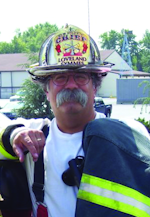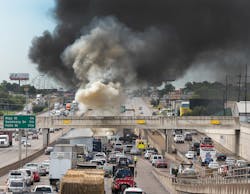Close Calls: Your Greatest Traumatic Risk as a Firefighter in 2020
As we start out 2020, it isn’t unusual to personally look back and reflect on the past year. That’s fine—reflect all that you want—but as far as your fire service role, let’s briefly look forward, knowing what we learned from last year.
The fact is that, as far as the fireground, seven firefighters died inside of a burning building in 2019.
According to the U.S. Fire Administration (USFA), as of 2018, there are about 1,216,600 firefighters who serve in 27,228 fire departments, which respond to emergencies from 58,150 fire stations. Of those firefighters, 31 percent, or 346,150, were career firefighters, and 69 percent, or 788,250, were volunteers. So, if we set our emotions aside for a moment, but still respect those who gave their life, the fact is, we are doing well specifically related to this category.
When you actually look at the numbers, the picture becomes even more clear; 2019 ended with the fewest firefighter on-duty deaths (57) since the USFA started tracking in 1976.
Is this a cause for celebration? Certainly not, but I am not one who believes that we must hit “zero,” because that’s impossible. Sure, it’s a target, but the fact is that this is a risky business, and, sometimes, no matter how much risk-management we do, we will lose good firefighters.
So, specific to structural firefighting, we must continue to learn, study, drill, train, drill and train—and it never ends. Strong focus on command and control, accountability, size-up, adequate “assured” staffing, water on the fire and continuing to be fire science students (by taking what we know and applying the latest facts) will help us to keep the interior structural firefighter death numbers low.
How we die
Statistically, our greatest loss of life as firefighters is cancer. It’s a huge deal, and Firehouse Magazine has devoted numerous supplements to everything that we need to understand to lower our risks. Even with that and all of the national efforts, in the first week of this new year, there was a significant fire in a metropolitan city, regarding which numerous photos were posted of firefighters blatantly ignoring what is now in 2020 “common sense” related to known cancer causing exposures: firefighters pulling their hoods over their faces while breathing smoke (despite having a perfectly good SCBA on their back); firefighters not wearing an SCBA yet climbing ladders to vent in conditions in which they were barely visible due to the thick smoke; and numerous firefighters completely covered with soot.
So, until we fully accept personal responsibility, and until all fire officers get tough and lead to minimize exposures, we will continue to watch “our own” and their families go into shock when we are diagnosed and only then start to grasp the avoidable versus the unavoidable. We’ll raise funds, sell shirts, do “go fund me” ... because we care! And we genuinely do. We also need to “care” before our own start to get sick and to suffer, as we watch these wonderful firefighters literally rot away. A little aggressive prevention, education and no-nonsense leadership matters.
Cancer is the No. 1 way that firefighters get sick. And die. Unfortunately, because exposure is a long-term issue, some firefighters fail to pay attention to the facts. Getting exposed is seen as “no big deal,” because nothing happens right away. It’s kind of a “human behavior” issue, not unlike, “Oh, I’ll just eat this fourth bacon double cheeseburger, because nothing will happen to me.” In that case, a friend, wife or child might be the one to correct that behavior when self-control isn’t applied. The cancer issue is similar: It might be another firefighter or a tough fire officer who corrects that behavior when self-control isn’t applied.
Your greatest ‘emergency’ risk
So, after cancer and medical emergencies, such as heart attack and stroke (which we won’t cover here), it’s the continuously emerging and growing challenge to survive on roadways that puts our life at risk next most often. What’s the cause? Generally, it’s distracted driving. People who drive automobiles are more distracted today than ever before simply because of the use of personal electronics in their vehicle. Of course, drunken or impaired driving and lack of sleep help pile on the level of risk to everyone on roadways—and notably us when we respond.
The following are brief overviews of some of the firefighters who were struck and killed in the line of duty in 2019. (Many others were struck and injured, and many were struck when they were off duty—but stopped to do the right thing to render aid.)
In November, Dwain S. Bradshaw was struck by a semitruck while he was operating at a previous crash on the Florida/Georgia line. He was a career firefighter for Naval Air Station Pensacola and a volunteer district fire chief at Escambia County, FL, Fire Rescue Station #1 in Bellview and the assistant district fire chief at Station #2 in Beulah. The truck that struck him hit two other vehicles before it left the roadway and hit Bradshaw.
In October, in Texas, a firefighter struck and killed a fellow firefighter and injured another. Louise, TX, Volunteer Fire Department member Steven Henderson and another firefighter were inspecting their apparatus on the side of the road upon return from an incident. The driver who struck the other two is a member of the same fire department and was driving a pick-up after responding to the same call that Henderson and his partner were returning from. The parked apparatus had its headlights on, but its emergency lights weren’t activated.
Also in October, a veteran South Carolina firefighter died after he was struck by a semitruck while checking on victims of a vehicle wreck. Lexington County, SC, Fire Service Firefighter/Engineer Paul Quattlebaum, Jr., was dispatched with his partner on a call and happened upon a vehicle wreck while en route to the original call. The firefighters stopped to check on the people who were involved in the wreck when Quattlebaum was struck.
In October as well, in San Antonio, Firefighter Greg Garza was killed after he was struck at the scene of an electrical fire at a hotel. When Garza and others arrived on scene, Garza stumbled or tripped getting off of an apparatus and was hit by a passing commercial van.
In 2017, in Mississippi, two firefighters who were members of the Oloh, MS, Volunteer Fire Department, were struck and killed while directing traffic at the site of a dump truck crash. Firefighters Clinton Alvin Beasley and Loretta Ann Sykes were hit by a driver who was fleeing the scene of the crash. Beasley and Sykes died of blunt force trauma.
Last month, Brandon Chance Eaton pleaded guilty to three felony counts of driving under the influence in the wreck that killed Beasley and Sykes and injured a third firefighter. The district attorney recommended a sentence of 60 years in prison, with 30 years to serve, according to the guilty plea.
As this issue was going to press, yet another tragedy on a highway occurred. Lubbock, TX, Fire Department Lieutenant David Hill and Lubbock, TX, Police Department police officer Nicholas Reyna were killed and firefighter Matthew Dawson was in critical condition after they were struck by a vehicle while working an icy wreck. While they worked two crashes, a vehicle crossed into the median and struck the two firefighters and the police officer.
Surviving in 2020
There are many ways to manage the risk of operating on roadways. The best way is to eliminate the risk by eliminating traffic in or near where members are operating. Be it diverting traffic or shutting down roads, when vehicles aren’t driving near us, we greatly increase our chances to survive.
Unfortunately, particularly when we first respond and arrive, traffic often still is moving all around us. The only solution is the adoption of the nationally recognized, locally adopted and trained upon Traffic Incident Management System (TIMS).TIMS consists of a planned and coordinated multidisciplinary process (police, fire-rescue-EMS, state officials as well as recovery services) to respond to and establish safe working environments for us while managing traffic, so it flows away from our working area or is completely diverted.
Getting the training is the first and most critical step in our ability to increase our chances of surviving on roadways. The fire service connection for each of us to become trained is through ResponderSafety.com. The training is online and at no cost. The website also provides opportunities for multi-agency drills and training, so cops know what firefighters are doing, and we know what cops are doing. Rest assured, your local law-enforcement folks understand today more than they did in previous years just how dangerous it is on the roadways. They almost always are willing to work with you, so they, too, can survive.
Three injury crashes occur every minute in the United States, putting nearly 39,000 incident responders potentially in harm’s way every day. Congestion from these incidents often generates secondary crashes, further increasing traveler delay and frustration ... and death.
The National Traffic Incident Management Responder Training was created by responders for responders. This course provides a shared understanding of the requirements for: safe, quick clearance of traffic incident scenes; prompt, reliable and open communication; and motorist and responder safeguards. First responders learn how to operate more efficiently and collectively.
In addition to training, numerous excellent manufacturers are working on new and unique technology to assist us in helping those who need us on the roadway but to enhance our survivability. As just one example, I recently had an opportunity to view some of that new technology from Whelen Engineering Company. The company’s engineers, who work with subject-matter experts from the fire, emergency-medical, law-enforcement and highway services, have done work related to the warning lights that are used on our apparatus and related vehicles.
One viewpoint holds that the more warning and flashing lights, the better. Very many might agree that concept is accurate during response. However, once we arrive on scene, another perspective states that there are cases where there are too many lights, which send confusing messages and, in some cases, cause more of a hazard due to intensity, volume and brightness.
The Dynamic Variable Intensity (DVI) system was developed specifically related to scene protection and traffic management/warning. Essentially this “smart” system changes the flash patterns and intensity of warning lights when apparatus and equipment arrive on scene. It “knows” whether it’s daylight or nighttime and whether the vehicle is stopped or moving. It then sets up some unique flash or steady-burning patterns that reportedly have been proven to provide a more positive, less confusing effect on those who are driving and approaching a scene. Instead of what can be perceived as confusion, the coordinating warning lights send a “message” that is one of calm and direction.
To increase our ability to survive on roadways, it will take a multifaceted approach between primarily us and law enforcement along with state departments of transportation and related partners. The first step for that to work is to start the lines of communication between all, set up meetings and make sure that the first order of business is to start the training—together.
Plus, be it on or off duty, do a proper size-up to do everything that you possibly can to minimize the chance of being struck.

Billy Goldfeder
BILLY GOLDFEDER, EFO, who is a Firehouse contributing editor, has been a firefighter since 1973 and a chief officer since 1982. He is deputy fire chief of the Loveland-Symmes Fire Department in Ohio, which is an ISO Class 1, CPSE and CAAS-accredited department. Goldfeder has served on numerous NFPA and International Association of Fire Chiefs (IAFC) committees. He is on the board of directors of the IAFC Safety, Health and Survival Section and the National Fallen Firefighters Foundation.








